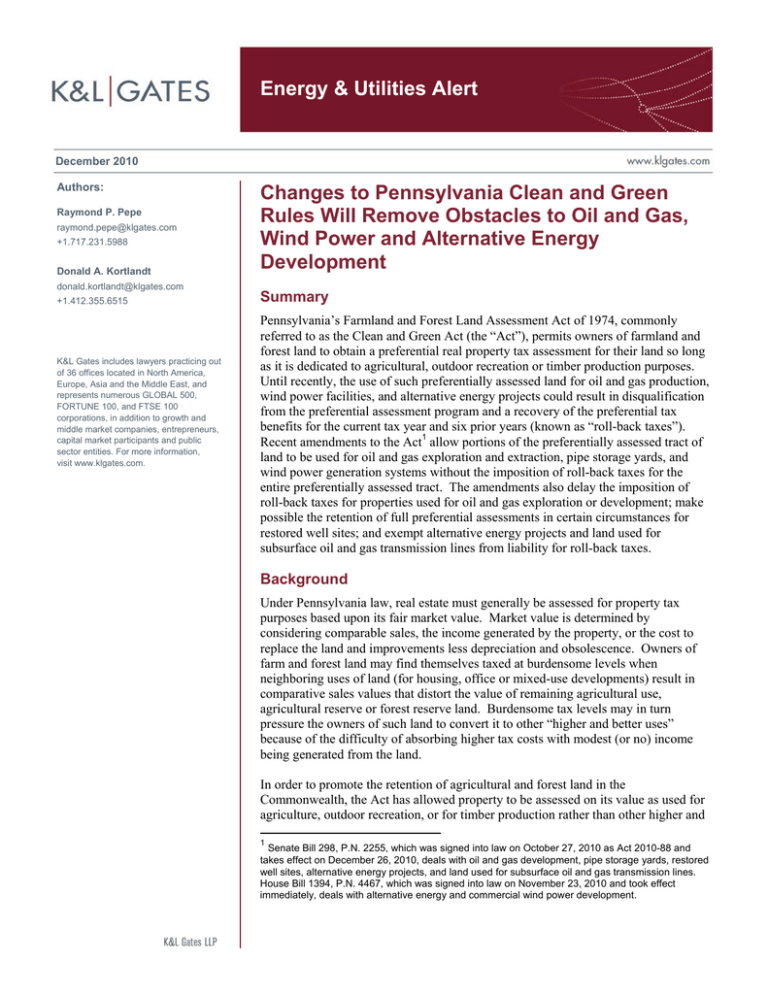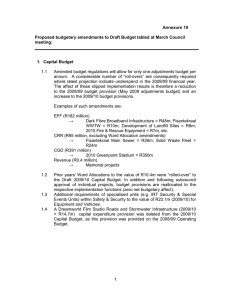
Energy & Utilities Alert
December 2010
Authors:
Raymond P. Pepe
raymond.pepe@klgates.com
+1.717.231.5988
Donald A. Kortlandt
donald.kortlandt@klgates.com
+1.412.355.6515
K&L Gates includes lawyers practicing out
of 36 offices located in North America,
Europe, Asia and the Middle East, and
represents numerous GLOBAL 500,
FORTUNE 100, and FTSE 100
corporations, in addition to growth and
middle market companies, entrepreneurs,
capital market participants and public
sector entities. For more information,
visit www.klgates.com.
Changes to Pennsylvania Clean and Green
Rules Will Remove Obstacles to Oil and Gas,
Wind Power and Alternative Energy
Development
Summary
Pennsylvania’s Farmland and Forest Land Assessment Act of 1974, commonly
referred to as the Clean and Green Act (the “Act”), permits owners of farmland and
forest land to obtain a preferential real property tax assessment for their land so long
as it is dedicated to agricultural, outdoor recreation or timber production purposes.
Until recently, the use of such preferentially assessed land for oil and gas production,
wind power facilities, and alternative energy projects could result in disqualification
from the preferential assessment program and a recovery of the preferential tax
benefits for the current tax year and six prior years (known as “roll-back taxes”).
Recent amendments to the Act1 allow portions of the preferentially assessed tract of
land to be used for oil and gas exploration and extraction, pipe storage yards, and
wind power generation systems without the imposition of roll-back taxes for the
entire preferentially assessed tract. The amendments also delay the imposition of
roll-back taxes for properties used for oil and gas exploration or development; make
possible the retention of full preferential assessments in certain circumstances for
restored well sites; and exempt alternative energy projects and land used for
subsurface oil and gas transmission lines from liability for roll-back taxes.
Background
Under Pennsylvania law, real estate must generally be assessed for property tax
purposes based upon its fair market value. Market value is determined by
considering comparable sales, the income generated by the property, or the cost to
replace the land and improvements less depreciation and obsolescence. Owners of
farm and forest land may find themselves taxed at burdensome levels when
neighboring uses of land (for housing, office or mixed-use developments) result in
comparative sales values that distort the value of remaining agricultural use,
agricultural reserve or forest reserve land. Burdensome tax levels may in turn
pressure the owners of such land to convert it to other “higher and better uses”
because of the difficulty of absorbing higher tax costs with modest (or no) income
being generated from the land.
In order to promote the retention of agricultural and forest land in the
Commonwealth, the Act has allowed property to be assessed on its value as used for
agriculture, outdoor recreation, or for timber production rather than other higher and
1
Senate Bill 298, P.N. 2255, which was signed into law on October 27, 2010 as Act 2010-88 and
takes effect on December 26, 2010, deals with oil and gas development, pipe storage yards, restored
well sites, alternative energy projects, and land used for subsurface oil and gas transmission lines.
House Bill 1394, P.N. 4467, which was signed into law on November 23, 2010 and took effect
immediately, deals with alternative energy and commercial wind power development.
Energy & Utilities Alert
better uses.2 Currently, more than 9.3 million acres
of land in the Commonwealth are subject to
preferential assessments established pursuant to the
Clean and Green Act.
To discourage conversion of the preferentially
assessed land to other uses, the Act imposes
significant roll-back taxes in the event all or
significant portions of the property are subsequently
converted or conveyed for other uses. Roll-back
taxes are calculated as the difference between the
taxes resulting from preferential assessment and the
taxes that would have been due had that land not
been preferentially assessed plus interest on the
deferred taxes from the date of deferral. Roll-back
taxes are payable for the year the land ceases to
qualify for Clean and Green status and the six
previous years in which the property was
preferentially assessed.
Prior to the recent amendments, if a landowner
changed the use of all or any portion of a tract of
land subject to preferential assessment to an
unauthorized use, both the land removed from use
for agriculture, outdoor recreation or timber
production, and the entire tract of which it was a
part, would be subject to roll-back taxes. Likewise,
if a preferentially assessed tract were to be divided
by a conveyance or other action of the owner into
two or more tracts, and one of the tracts no longer
qualified for preferential assessment, the owner of
the ineligible property would become liable for a
roll-back tax based on the fair market value of the
entire property. Except as otherwise provided by the
recent amendments, roll-back taxes become due at
the time of the change in use to an unauthorized
purpose and create a lien against the property.
Although the Act previously provided partial relief
from the imposition of roll-back taxes in a limited
number of circumstances, such as the leasing of up
to one-half acre of land for telecommunications
purposes or limited split-offs of land for residential
construction, those exceptions were not helpful in
many circumstances and the threat of roll-back taxes
had become a significant issue for landowners
2
Agricultural use includes the use of land for the production of
a broad range of agricultural, apicultural, aquacultural,
horticultural, floricultural, silvicultural, viticultural and dairy
products, and for the processing of farm products and for the
location of a farm residence.
considering leasing portions of their property for
alternative energy, wind, and oil and gas activities.
With the rapid development of the oil and gas and
commercial wind power industries in Pennsylvania,
and the emerging development of alternative energy
projects to supply power to landowners, potential
liability for roll-back taxes had become a significant
deterrent to landowners availing themselves of these
emerging opportunities if their land was enrolled in
the Clean and Green program. The recently enacted
amendments address these concerns by providing
various limitations and exceptions to exposure for
roll-back taxes.
Oil and Gas Development
The newly enacted Clean and Green Act
amendments make it possible for a landowner to
lease property for the exploration and removal of
gas and oil, including coal bed methane, and for the
development of related facilities such as roads and
bridges, pipelines and buildings or structures,
without the imposition of roll-back taxes until (1)
the land is actually devoted to such activities; and
(2) a well site restoration report is approved by the
Department of Environmental Protection, if it is
determined that the land is incapable of being
immediately used for agriculture, outdoor recreation
or timber production purposes. Upon the filing of
an approved well site restoration report, roll-back
taxes will be imposed only on portions of the land
incapable of being used for agriculture, public
recreation or timber development, and the fair
market value of the land will be adjusted
retroactively to the date a permit for the use of the
land was issued under the Oil and Gas Act. Rollback taxes will not be levied, however, for land
devoted to subsurface transmission or gathering
lines.
Thus, in contrast to the prior provisions of the Act,
instead of an entire property becoming ineligible for
preferential tax treatment when disqualifying
activities took place on any significant part of the
land, the preferential tax treatment will be revoked
only for those specific sections of the property no
longer capable of agricultural or forest uses, thereby
resulting in a substantial reduction of roll-back
taxes. In addition, rather than imposing roll-back
taxes immediately upon the change in the use of
land to an unauthorized purpose, the amendments
December 2010
2
Energy & Utilities Alert
defer the imposition of roll-back taxes until a site
restoration report is approved by the Department of
Environmental Protection. Because leases may be
executed several years in advance of the actual
development of a property, and a site restoration
reports need not be submitted until eleven months
after the completion of drilling or well plugging,
these amendments may significantly delay the
imposition of roll-back taxes.3
In addition, no roll-back tax may be imposed upon a
landowner for activities related to the exploration for
or removal of oil or gas conducted by parties other
than the landowner that hold the rights to conduct
such activities pursuant to mineral lease or other
instrument or conveyance, if the transfer of the
rights occurred (1) before the land was enrolled for
preferential assessment under this act; and (2) before
December 26, 2010. These amendments protect
surface landowners from liability for roll-back taxes
in circumstances where they lack the ability to
control the commencement of oil and gas
development. As a result, parties engaging in
conveyances of oil and gas development rights after
December 26, 2010, should be careful to clarify the
extent to which the landowners or mineral lessees
will be liable to roll-back taxes.
The amendments also permit the owner of property
subject to preferential assessment to temporarily
lease a portion of the land for pipe and storage yards
subject to roll-back taxes imposed only the portions
of the land temporarily leased or otherwise devoted
to pipe storage yards without invalidating the
preferential assessment of other portions of the
property, provided that upon the expiration of the
lease the land is restored to its original use that
qualified it for preferential assessment.
Commercial Wind Power Development
Portions of land subject to preferential assessment
may be leased or otherwise devoted to a wind power
generation system, subject to the imposition of rollback taxes only on those portions of the land
3
Within 60 days after the restoration of a well site, a well site
restoration report must be submitted to the Department of
Environmental Protection. Well site restoration must be
completed within nine months after completion of drilling of any
well used for production or within nine months after plugging a
well. See 25 Pa. Code § 78.65 and 58 P. S. § 601.206.
occupied by the wind power generation system
which would include the foundation of a wind
turbine and the area of the surface covered by
appurtenant structures, including new roads and
bridges, transmission lines, substations and other
buildings or structures related to the wind power
generation system. Thus, utilization of a portion of
a preferentially assessed tract for a wind power
generation system will not invalidate the
preferential assessment of land not utilized for wind
power generation, and the land may continue to
receive preferential assessments to which it would
otherwise be qualified. Notice of installation of a
wind power generation system must be given to the
county tax assessment office not later than thirty
days following the commencement of electricity
generation and roll-back taxes are due on the date
the notice is given.
Alternative Energy Projects
Land may continue to qualify as being in
agricultural use, or as an agricultural or forest
reserve, if the land is devoted to the development of
an alternative energy system, provided that a
majority of the energy generated annually is used on
the tract. An alternative energy system is a system
that generates photovoltaic solar energy or thermal
energy, wind power, low-impact hydropower,
geothermal energy, biologically derived methane
gas, fuel cells, biomass, or coal mine methane. A
system does not lose its qualification as an
alternative energy project if some portion of the
energy produced is delivered to an energy
distribution company or regional transmission
system (that is, sold to the “grid”), so long as a
majority of energy produced is used onsite.
Effective Date
The amendments to the Clean and Green Act
affecting oil and gas development, pipe storage
yards, restored well sites, and land used for
subsurface oil and gas transmission lines take effect
December 26, 2010, and the provisions dealing with
alternative energy projects and wind power
development took effect on November 23, 2010. As
a result, no roll-back taxes may be imposed after
these dates in a manner contrary to amendments,
and the enrollment of property may not be denied
based upon leases or plans that will result in the
conversion of property in the future to uses as
authorized by the amendments that will require the
December 2010
3
Energy & Utilities Alert
imposition of roll-back taxes, but which do not
currently change the use of the land. The
amendments do not provide, however, for the
payment of refunds on roll-back taxes previously
levied.
Conclusion
The Clean and Green Act amendments represent a
significant reform benefiting landowners, and
helping to promote wind, alternative energy and oil
and gas production, while continuing to encourage
open-space preservation. These amendments should
facilitate project leasing and development by
clarifying the rules of the road, and avoiding
draconian roll-back taxes assessed against lands that
remain in open-space uses.
Anchorage Austin Beijing Berlin Boston Charlotte Chicago Dallas Dubai Fort Worth Frankfurt Harrisburg Hong Kong London
Los Angeles Miami Moscow Newark New York Orange County Palo Alto Paris Pittsburgh Portland Raleigh Research Triangle Park
San Diego San Francisco Seattle Shanghai Singapore Spokane/Coeur d’Alene Taipei Tokyo Warsaw
Washington, D.C.
K&L Gates includes lawyers practicing out of 36 offices located in North America, Europe, Asia and the Middle East, and represents numerous
GLOBAL 500, FORTUNE 100, and FTSE 100 corporations, in addition to growth and middle market companies, entrepreneurs, capital market
participants and public sector entities. For more information, visit www.klgates.com.
K&L Gates is comprised of multiple affiliated entities: a limited liability partnership with the full name K&L Gates LLP qualified in Delaware and
maintaining offices throughout the United States, in Berlin and Frankfurt, Germany, in Beijing (K&L Gates LLP Beijing Representative Office), in
Dubai, U.A.E., in Shanghai (K&L Gates LLP Shanghai Representative Office), in Tokyo, and in Singapore; a limited liability partnership (also named
K&L Gates LLP) incorporated in England and maintaining offices in London and Paris; a Taiwan general partnership (K&L Gates) maintaining an
office in Taipei; a Hong Kong general partnership (K&L Gates, Solicitors) maintaining an office in Hong Kong; a Polish limited partnership (K&L
Gates Jamka sp. k.) maintaining an office in Warsaw; and a Delaware limited liability company (K&L Gates Holdings, LLC) maintaining an office in
Moscow. K&L Gates maintains appropriate registrations in the jurisdictions in which its offices are located. A list of the partners or members in each
entity is available for inspection at any K&L Gates office.
This publication is for informational purposes and does not contain or convey legal advice. The information herein should not be used or relied upon
in regard to any particular facts or circumstances without first consulting a lawyer.
©2010 K&L Gates LLP. All Rights Reserved.
December 2010
4



